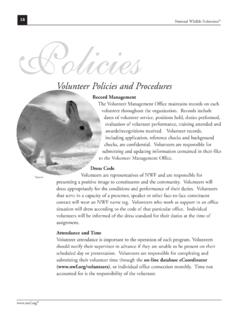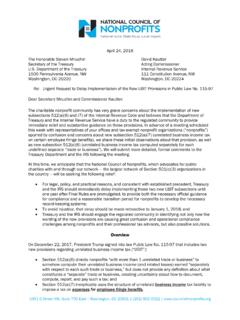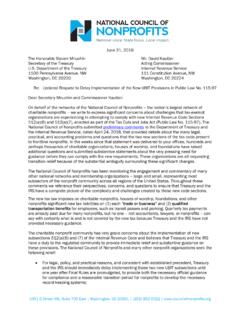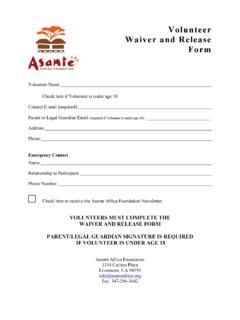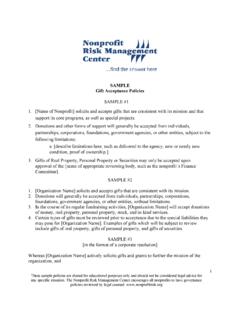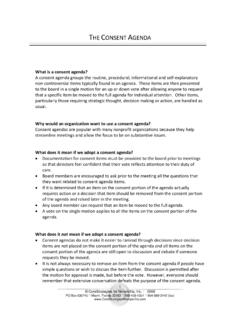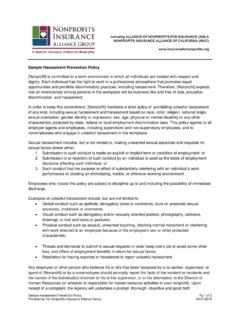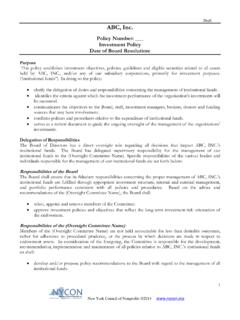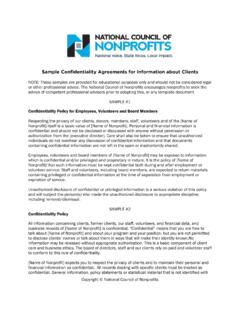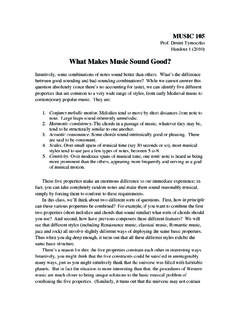Transcription of How to be a Great Board Member - National Council of ...
1 How to Be a Great Nonprofit Board Member Make A Difference Originally presented September 22, 2009 at the Nonprofit Risk Management Center s 2009 Risk Management and Finance Summit for Nonprofits Characteristics Weak MembersOK MembersGood MembersGreatMembersWhat they say It ll look Great on my resume! What do I have to do? How may I help? Thanks for the opportunity. What they add dead weightbasicsdedicationpassionWhat they take valuable spotinstructionsrole seriouslytime to careHow they look cool regulareagerunassumingWhat they read TV GuideTime magazinebooksRobert GreenleafWhom they serve themselvestheir obligationsthe nonprofitthe community 2009 National Council of Nonprofits.
2 All rights reserved. 2 Weak Board members Weak = inadequate; deficient FOCUS on themselves A visit to Noah s ark provides tremendous insight to the wide range of weak Board members : turkeys = just like most Americans have a big turkey dinner once or twice a year, these Board members show up only once or twice a year to attend Board meetings, meaning that these AWOL members take up valuable spots that others who would be more committed could fill skunks = these people join boards for business development purposes rather than to serve the broader community and advance the cause of the nonprofit organization.
3 You can smell these stinkers a mile away show horses = these Board members show up to take the credit for work done by others, often stomping on the toes of those who went the extra mile behind the scenes to ensure that the nonprofit s important programs happened mockingbirds = these Board members show up at Board meetings to cackle and listen to their own voices rather than to add real value or insight (turkeys are bad, but at least they don t actively disrupt like mockingbirds do) chameleons = these creatures agree to do things, but then disappear, never to be found when everyone else is counting on them to deliver the promised work monkeys = these Board members have a monkey see, monkey do attitude, so when it is time to do something they simply copy what was done last year, rather than adding improvements and value NOTE: This analysis is not a knock on animals.
4 Many animals have Great skills that add tremendous value to Board service. For example, geese share leadership responsibility by rotating through the tough point position, encourage the leader by honking encouragement, and are smart enough to know they can travel further when they fly together. Eagles soar to Great heights to get a better perspective for a clear vision. Beavers build elaborate dams without a head beaver yelling orders at everyone. Moral: As you begin your Board service, pick your animal: show horse or work horse, turkey or goose. 2009 National Council of Nonprofits.
5 All rights reserved. 3 OK Board members OK = adequate; meets the minimum requirements FOCUS on strengthening their basic skills A. Duty of Care 1. The duty of care requires that first, a director be informed; and second, a director discharge his [or her] duties in good faith, with the care that an ordinarily prudent person in a like position would reasonably believe appropriate under similar circumstances. ABA Guidebook for Directors of onprofit Corporations. 2. The duty of care does not speak to the question of the correctness of the decision, but rather to the manner in which the Board Member carried out the decision.
6 Warren Ilchman & Dwight Burlingame, Accountability in a Changing Philanthropic Environment, in Philanthropy and the onprofit Sector. 3. Among other things, Board members must: attend meetings regularly (and review materials before meetings!) stay adequately informed about the organization exercise independent judgment when voting ABA Guidebook B. Duty of Loyalty 1. [B]oard members must give undivided allegiance to the organization when making decisions affecting the organization. The Legal Obligations of onprofit Boards. 2. The duty of loyalty speaks to the responsibility of the director to act in a manner that will not harm the organization served.
7 And prohibits directors from obtaining personal benefit or gain that rightly belong to the nonprofit organization. Ilchman & Burlingame. 3. The duty of loyalty primarily relates to: conflicts of interests; corporate opportunity; and confidentiality. Also, the director s duty of loyalty lies with the interests of the corporation, not to any constituency group. ABA Guidebook. C. Duty of Obedience 1. The duty of obedience mandates that directors carry out the purposes of the organization as spelled out in its articles of incorporation and other legal documents.
8 Ilchman & Burlingame. 2. Internal -- Board members have a duty to ensure the organization remains obedient to its central purposes as shown in its articles of incorporation, mission statement, bylaws, and other internal documents. The Legal Obligations of onprofit Boards. 3. External -- Board members have a duty to ensure the organization complies with public laws, such as federal and state laws concerning transparency ( , making tax returns and other nonprofit filings available for inspection), solicitations ( , making required disclosures), and normal employment laws (such as tax withholdings).
9 2009 National Council of Nonprofits. All rights reserved. 4 good Board members good = desirable; more than adequate; leadership material FOCUS on strengthening the nonprofit Your role as a trustee has two aspects: fiduciary and supportive. As a representative of the public at large you have a fiduciary obligation to watch out for the public interest. Your supportive role is to help make the organization work, to assist it in achieving its mission. --Fisher Howe, in Welcome to the Board While some people assert that nonprofits should be more business-like, good Board members recognize that in many ways nonprofits are more similar to the government sector than the business sector, in that each involves public service for the common good .
10 Consider: Board = Legislative branch The nonprofit Board is like the legislative branch in that it: sets the general direction and broad policies, but normally does not directly execute that policy adopts the budget and ensures there are sufficient resources to meet the nonprofit s needs Executive Director and Staff = Executive branch The general rule is that the directors oversee, but do not directly engage in the corporation s day-to-day operations. ABA Guidebook. Boards and Board members perform best when they exercise their responsibilities primarily by asking good and timely questions rather than by running programs or implementing their own policies.

